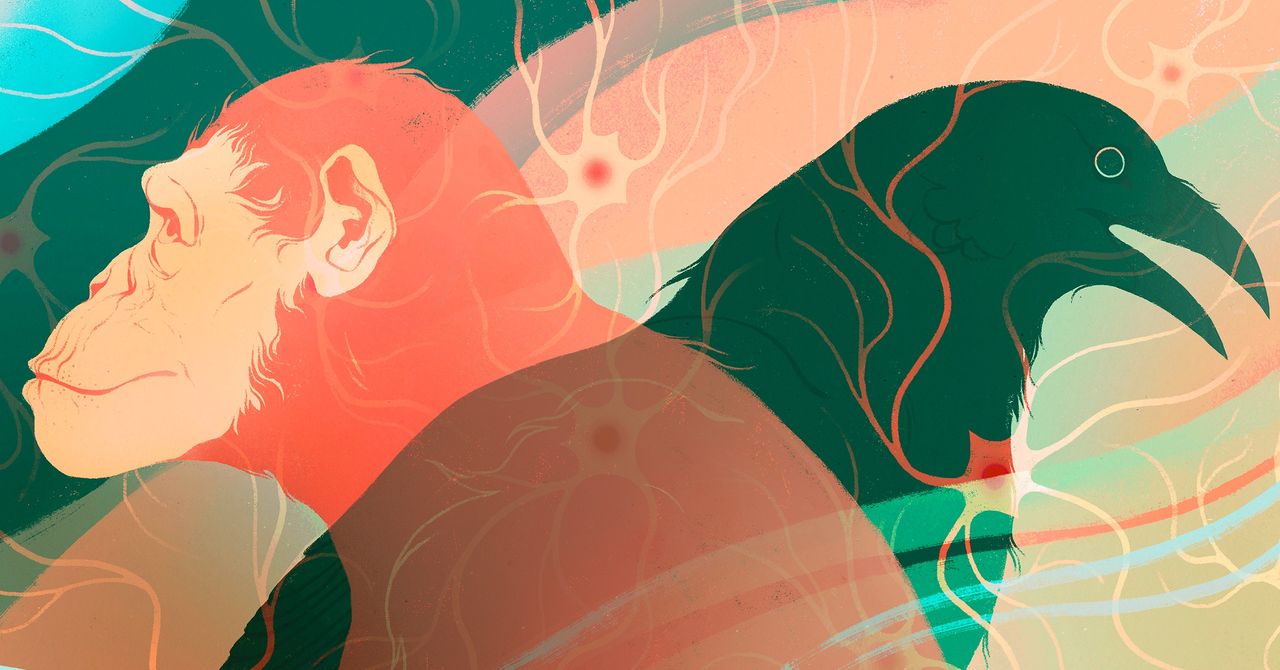“How we end up with similar circuitry was more flexible than I would have expected,” Zaremba said. “You can build the same circuits from different cell types.”
Zaremba and her team also found that in the bird pallium, neurons that start development in different regions can mature into the same type of neuron in the adult. This pushed against previous views, which held that distinct regions of the embryo must generate different types of neurons.
In mammals, brain development follows an intuitive path: The cells in the embryo’s amygdala region at the start of development end up in the adult amygdala. The cells in the embryo’s cortex region end up in the adult cortex. But in birds, “there is a fantastic reorganization of the forebrain,” Güntürkün said, that is “nothing that we had expected.”
Taken together, the studies provide the clearest evidence yet that birds and mammals independently evolved brain regions for complex cognition. They also echo previous research from Tosches’ lab, which found that the mammalian neocortex evolved independently from the reptile DVR.
Still, it seems likely there was some inheritance from a common ancestor. In a third study that used deep learning, Kempynck and his coauthor Nikolai Hecker found that mice, chickens, and humans share some stretches of DNA that influence the development of the neocortex or DVR, suggesting that similar genetic tools are at work in both types of animals. And as previous studies had suggested, the research groups found that inhibitory neurons, or those that silence and modulate neural signals, were conserved across birds and mammals.
The findings haven’t completely resolved Karten and Puelles’ debate, however. Whose ideas were closer to the truth? Tosches said that Puelles was right, while Güntürkün thought the findings better reflect Karten’s ideas, though would partly please Puelles. García-Moreno split the difference: “Both of them were right; none of them was wrong,” he said.
How to Build Intelligence
Intelligence doesn’t come with an instruction manual. It is hard to define, there are no ideal steps toward it, and it doesn’t have an optimal design, Tosches said. Innovations can happen throughout an animal’s biology, whether in new genes and their regulation, or in new neuron types, circuits, and brain regions. But similar innovations can evolve multiple times independently—a phenomenon known as convergent evolution—and this is seen across life.
“One of the reasons I kind of like these papers is that they really highlight a lot of differences,” said Bradley Colquitt, a molecular neuroscientist at UC Santa Cruz. “It allows you to say: What are the different neural solutions that these organisms have come up with to solve similar problems of living in a complex world and being able to adapt in a rapidly changing terrestrial environment?”
Octopuses and squids, independently of mammals, evolved camera-like eyes. Birds, bats and insects all took to the skies on their own. Ancient people in Egypt and South America independently built pyramids—the most structurally efficient shape that will stand the test of time, García-Moreno said: “If they make a tower, it will fall. If they make a wall, it won’t work.”
Similarly, “there’s limited degrees of freedom into which you can generate an intelligent brain, at least within vertebrates,” Tosches said. Drift outside the realm of vertebrates, however, and you can generate an intelligent brain in much weirder ways—from our perspective, anyway. “It’s a Wild West,” she said. Octopuses, for example, “evolved intelligence in a way that’s completely independent.” Their cognitive structures look nothing like ours, except that they’re built from the same broad type of cell: the neuron. Yet octopuses have been caught performing incredible feats such as escaping aquarium tanks, solving puzzles, unscrewing jar lids and carrying shells as shields.
It would be exciting to figure out how octopuses evolved intelligence using really divergent neural structures, Colquitt said. That way, it might be possible to pinpoint any absolute constraints on evolving intelligence across all animal species, not just vertebrates.
Such findings could eventually reveal shared features of various intelligences, Zaremba said. What are the building blocks of a brain that can think critically, use tools, or form abstract ideas? That understanding could help in the search for extraterrestrial intelligence—and help improve our artificial intelligence. For example, the way we currently think about using insights from evolution to improve AI is very anthropocentric. “I would be really curious to see if we can build like artificial intelligence from a bird perspective,” Kempynck said. “How does a bird think? Can we mimic that?”
Original story reprinted with permission from Quanta Magazine, an editorially independent publication of the Simons Foundation whose mission is to enhance public understanding of science by covering research developments and trends in mathematics and the physical and life sciences.
